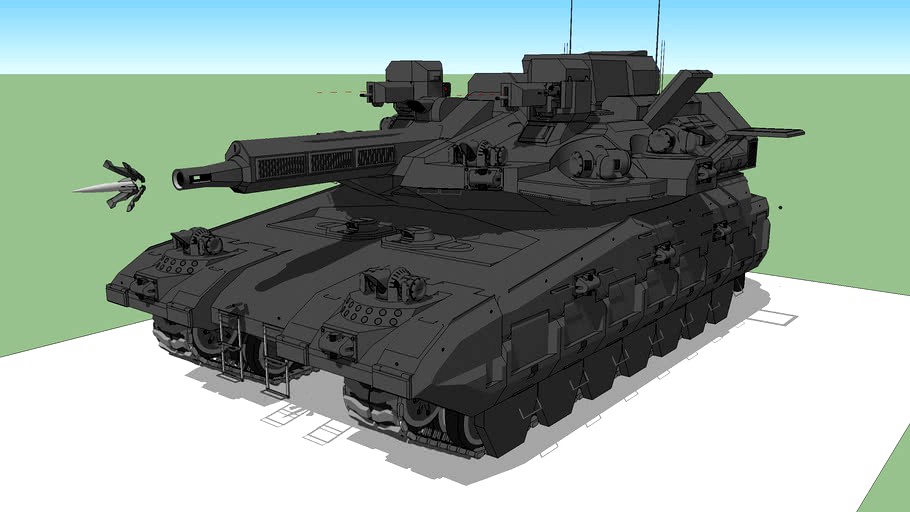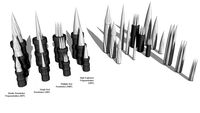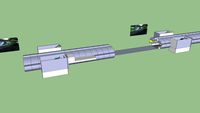3DWarehouse

ATS-MBTV Anvil Mark II
by 3DWarehouse
Last crawled date: 2 years, 10 months ago
WORK IN PROGRESS Advanced Track System - Main Battle Tank Variant “Anvil” Mark II The Mark II variant of the ATS-MBTV “Anvil” is the primary heavy assault vehicle of the United Human Nations Defense Forces (UHNDF). It acts as both a traditional “main battle tank” as well as a mobile artillery system. The ability to vertically elevate its barrel 65 degrees provides long range indirect-fire capability (up to 250 km/155 miles). This allows the vehicle to rapidly transition from a frontal assault role to a long range support role. This role-flexibility is crucial to the synergy of ground based tactics, as dormant sectors of the front line can quickly support sectors that are being contested. This overlapping indirect-fire coverage of the front line by adjacent units is termed an “artillery phalanx.” The Anvil’s IIRM launcher provides offensive capabilities in close quarter situations. The original Mark II only had two Anti-Projectile Pulse Lasers (APPLs), which could defend against longer range indirect fire but was inadequate in dealing with incoming close range direct-fire. Thus, the upgraded Mark II-B was created with an additional pair of Anti-Projectile Point Defense Cannons (APPDCs). The APPDC consists of two 40mm cannons, with one firing a grenade and the other firing a shotgun-like blast of pellets. The primary purpose of both cannons is to disrupt the penetrating capability of incoming medium to large caliber projectiles. The system can also be used to target nearby enemy infantry. The Anvil can also act as a forward controller of unmanned vehicles and drones. It is often escorted by a number of UAWSs to provide greater offensive and defensive capabilities. Since all ATS variants carry six quadcopter scout drones, the Anvil can also conduct short- to mid-range scouting operations. Although the Mark I had entered a limited production phase shortly after the beginning of the Tower War, the development of newer technologies and adjustment of battlefield tactics against the Caudatians shed light on potential weaknesses of the tank. After rigorous testing of the upgraded Mark I, it was decided that many of its design features were not up to the standards of modern combat against the alien threat. Modifications included an almost complete redesign of the turret and upgrades to most weapon and sensor systems. The frontal armor of both the turret and hull was thickened significantly and was angled more to defend against direct-fire. Increased armor on the side-skirt system was also added. Although the increased armor reduced the tank’s top speed, upgrades to the tank’s powertrain actually improved the tank’s max torque and acceleration which is seen as more important in combat situations. One large concern was small caliber sub-munitions and hypersonic shrapnel impacts that became common as incoming projectiles were destroyed by close-in defense systems. While these impacts could not penetrate the thick primary armor of the hull, they could easily damage or destroy mounted weaponry and equipment. Thus, thicker casings and protective covers for exposed weaponry, sensor suites, and other equipment were added. In some situations where heavy enemy bombardment was anticipated such as beach landings, large protective covers were added on top of the tanks for more protection against these indirect fire threats. After the capture of Caudatian battery technologies in 2067, the primary 120mm cannon was upgraded from hybrid chemical/electromagnetic propulsion to exclusively electromagnetic, greatly increasing its projectiles’ muzzle velocity and destructive effects. This also allowed for quicker reload times due to the lack of shell casings. However, the increased recoil of the primary gun required large modifications to the recoil mechanism, including a soft-recoil option for high powered shots. Coolant systems for the barrel also had to become more complex to avoid warping of the rails during prolonged engagements. Other modifications include: two more sensor suites to the front of the turret to boost the situational awareness of the commander and gunner, the moving of the scout drone docking stations from the hull to the turret, and an ammunition access hatch on the rear of the turret for faster rearmament. The rear infantry compartment was also removed to make room for additional batteries and coolant. In the duration of the Tower War, over 20,000 Anvil variants of the ATS family were produced. Due to the prominence of fully automated weapon systems on the front lines, Anvil losses were relatively low at about 10%. Of these losses, only about 25% of the crew died due to the infrequent nature of long range follow-up attacks. Most of these losses occurred during Caudatian counter-attacks that broke through the frontal automated defense line or in the close quarter situations of urban combat. Operational Crew: 4 (Commander, gunner/loader, driver, and drone operator/intelligence officer). Each crew station is identical which allows crew to easily switch roles if one member is knocked out. Armament/Equipment: 1 x 120mm Heavy Rail Cannon (70 round magazine, plus additional 25 in reserve) 3 x 13.5mm Heavy Rail Guns (One mounted coaxially with the 120mm HRC and two mounted in weapon platforms around the Gunner and Commander’s hatches) 2 x 6.35mm Light Rail Guns (LRG-15/Vs, mounted in weapons platforms around the Gunner and Commander's hatches) 2 x Anti-Projectile Pulse Lasers (APPL) 2 x Anti-Projectile Point Defense Cannons (APPDC) 6 x Intermediate Internal Rail Missiles (IIRM) 6 x Quadcopter scout drones 6 x Situational sensor suites (includes multiple high-zoom cameras, acoustic ranging systems, laser designators and rangefinders, smoke grenade launchers, and floodlights) 13 x Drive sensor suites (includes proximity 3D laser scanning and radar systems) 18 x Vertical launching point-defense scout drones (usually used in tandem with smoke grenade launchers to maintain local situational awareness while in cover) There are four primary types of 120mm ammunition: 1) Kinetic Penetrator Fragmentation (KPF), 2) Single Rod Penetrator (SRP), 3) Multiple Rod Penetrator (MRP), and 4) High Explosive Fragmentation (HEF). - Kinetic Penetrator Fragmentation (KPF) These rounds have a solid armor piercing tip that disconnects from the rear section soon after exiting the muzzle. The less aerodynamic rear section contains an explosive charge and shrapnel fragments. In the delayed fragmentation mode, moments after the kinetic penetrator impacts, the delayed rear section travels through the breach and explodes. In external fragmentation mode, the rear section explodes before it enters the breach. Delayed fragmentation is usually used against buildings or lightly armored vehicles while external fragmentation is used against more heavily armored vehicles to damage external systems. - Single Rod Penetrator (SRP) These rounds consist of one long, slender rod that is capable of penetrating the thickest of armor. -Multiple Rod Penetrator (MRP) These rounds are made up of seven rods similar to the SRP, only smaller. They are enclosed in a canister before being fired and separate from each other upon exiting the muzzle. Although each individual rod does not contain the same amount of kinetic energy as the SRP, they are still more effective against armor than the KPF’s kinetic penetrator tip. These rounds are used primarily against light to medium armored targets. -High Explosive/Fragmentation (HEF) These rounds consist entirely of explosive material and a fragmenting shell. These are mostly used as long-range airburst weapons or against groups of infantry. Armor: Carbon nanotube infused composite armor (titanium, aluminum, and iron alloys). Armor is produced by an additive manufacturing process (a.k.a. 3D printing) that creates a pattern that disrupts kinetic penetrators. This process also reduces unnecessary weight. A coating of rubberized metamaterial is applied to all surfaces to reduce electromagnetic signatures. This also makes the tank nearly invisible when in fog or smoke. Average armor thickness: 150mm (6 inches) Maximum Speed: On road: 76 km/h (47 mph) Off road: 53 km/h (33 mph) Weight: 40 metric tons (44.1 short tons, or 88,200 lbs) Length: meters (26ft 6in) Chassis width: 4.52 meters (16ft 7in) Turret width: 4.79 meters (16ft 5in) Height (to top of IIRM launcher): 3.72 meters (12ft 2in) Ground clearance: 0.37 meters (1ft 2in) #armor #armored_fighting_vehicle #battle_tank #fighting_vehicle #heavy #heavy_armor #Main_Battle_tank #rail_gun #railgun #tank #tower
Similar models
3dwarehouse
free

Rail Cannon Ammunition
...(mrp) these rounds are made up of seven rods similar to the srp, only smaller. they are enclosed in...
3dwarehouse
free

ATS-ISV 'Hammer' Mark II
...(mrp) these rounds are made up of seven rods similar to the srp, only smaller. they are enclosed in...
3dwarehouse
free

HHT-43(Heavy Howitzer Tank)
...se purposes only. the two turrets on the front are also only used for defensive reasons. #big #cannon #gun #hht43 #howitzer #tank
3dwarehouse
free

Madjemascorp tripple howitzer.
...rect highly explosive shell firing. 3 barrels, high firing rate. ground units only. #cannon #howitzer #tank #turret #war #warrior
3dwarehouse
free

GP-7 AT Gauss Turret (1m)
...ut please do credit me for the turret. #1m #anti #beam #camo #cannon #gauss #gp7 #gun #heavy #magnet #steel #tank #turret #weapon
3dwarehouse
free

Six Shooter
... #dune #fire #future #gatling #gun #hummer #iraq #leg #mek #missile #robotmech #sci_fi #scifi #six_shooter #tank #zardoz #zarrdoz
3dwarehouse
free

AA turret
... can be operated by 1 man and the small guns are loaded externaly for a quick loading process so the gun can constantly be firing
3dwarehouse
free

Battleship defense turret
.........down sorry for bad english,from vietnam,and i know this model it's not the best,but,please rate it with beginner level!
3dwarehouse
free

Vernian Rail Cannon
...fireing ,massive recoil means only large ships can carry them, can't rotate at present #cannon #railgun #space_ships #weapons
3dwarehouse
free

Kriss turret
...re armor was designed to be replaceable #alm_model_works #cool #future_wars #louielikespie #loupie #new #pav #tank #tanks #turret
Ats
3dwarehouse
free

ATS
...ats
3dwarehouse
ats #ats
3dwarehouse
free

ats
...ats
3dwarehouse
ats
3dwarehouse
free

ATS
...ats
3dwarehouse
ats #鱼缸
3dwarehouse
free

ATS
...ats
3dwarehouse
automatic transfer switch #ats #box #cummins #generator
3dwarehouse
free

ats
...ats
3dwarehouse
3dwarehouse
free

ATS
...ats
3dwarehouse
3dwarehouse
free

ats
...ats
3dwarehouse
3dwarehouse
free

A ATS
...a ats
3dwarehouse
3dwarehouse
free

ATS
...ats
3dwarehouse
3dwarehouse
free

ATS BURO
...ats buro
3dwarehouse
ats buro #ats_buro
Anvil
3dwarehouse
free

Anvil
...anvil
3dwarehouse
anvil #anvil #blacksmith #blacksmithing #farrier
3dwarehouse
free

Anvil
...anvil
3dwarehouse
anvil graphic for my business #anvil #blacksmith
3dwarehouse
free

Anvil
...anvil
3dwarehouse
anvil
3dwarehouse
free

Anvil
...anvil
3dwarehouse
a basic anvil for use in a forge. #anvil #blacksmith #forge #hammer
3dwarehouse
free

Anvil
...anvil
3dwarehouse
an anvil. #anvil_incudine
3dwarehouse
free

Anvil
...anvil
3dwarehouse
just an anvil.
3dwarehouse
free

An anvil
...an anvil
3dwarehouse
a metal anvil
3dwarehouse
free

Anvil
...anvil
3dwarehouse
anvil with metal texture
3dwarehouse
free

Anvil
...ore technically correct than most of the anvils found in the warehouse so far #amboss #anvil #blacksmith #forge #schmiede #smithy
3dwarehouse
free

Anvil
...anvil
3dwarehouse
low poly anvil ready for #subdivision
Mark
3dwarehouse
free

mark
...mark
3dwarehouse
mark
3dwarehouse
free

Mark
...mark
3dwarehouse
my name #mark #sketchup
3dwarehouse
free

mark
...mark
3dwarehouse
dude man thingy #afro #guy #mark #person
3dwarehouse
free

Mark
...mark
3dwarehouse
a new version of sang but now is named mark from technical support. #techscam
3dwarehouse
free

MARKE
...marke
3dwarehouse
marke stoel zonder armleuning hout #projectinrichting #furniture #chair #woodenchair #horeca
3dwarehouse
free

mark
...mark
3dwarehouse
3dwarehouse
free

Mark
...mark
3dwarehouse
3dwarehouse
free

Mark A
...mark a
3dwarehouse
3dwarehouse
free

Mark
...mark
3dwarehouse
3dwarehouse
free

Mark
...mark
3dwarehouse
Ii
3dwarehouse
free

ii
...ii
3dwarehouse
ii
3dwarehouse
free

ii
...ii
3dwarehouse
ii
3dwarehouse
free

ii
...ii
3dwarehouse
ii
3dwarehouse
free

ii
...ii
3dwarehouse
ii
3dwarehouse
free

ii
...ii
3dwarehouse
ii
3dwarehouse
free

ii
...ii
3dwarehouse
ii
3dwarehouse
free

Subway II
...subway ii
3dwarehouse
subway ii #ii #subway
3dwarehouse
free

ii
...ii
3dwarehouse
3dwarehouse
free

ii
...ii
3dwarehouse
3dwarehouse
free

,ii,
...,ii,
3dwarehouse
